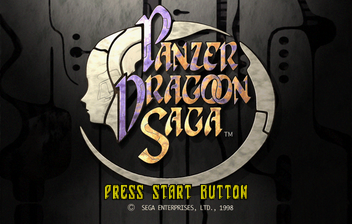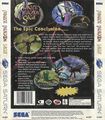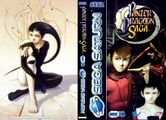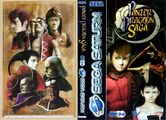Difference between revisions of "Panzer Dragoon Saga"
From Sega Retro
m (Text replace - 'screenwidth=320px' to 'screenwidth=320') |
|||
| Line 1: | Line 1: | ||
{{Bob | {{Bob | ||
|bobscreen=PanzerDragoonSaga title.png | |bobscreen=PanzerDragoonSaga title.png | ||
| − | |screenwidth= | + | |screenwidth=320 |
|publisher=[[Sega]] | |publisher=[[Sega]] | ||
|developer=[[Team Andromeda]] | |developer=[[Team Andromeda]] | ||
Revision as of 22:18, 7 November 2011
| Panzer Dragoon Saga |
|---|
| System(s): Sega Saturn |
| Publisher: Sega |
| Developer: Team Andromeda |
| Genre: RPG |
Panzer Dragoon Saga, called Azel: Panzer Dragoon RPG (AZEL -パンツァードラグーンRPG-) in Japan, is a critically-acclaimed role-playing game released exclusively for the Sega Saturn in 1998. It was the third Panzer Dragoon game to be released and so far remains the only game in the series that is not a Rail Shooter. Like the other Panzer Dragoon games on the Saturn, it was developed by Sega's internal Team Andromeda development studio. The team disbanded after Saga's release.
Contents
Synopsis
The player controls Edge, a young hunter, as he attempts to free the world from the will of the Ancients with the help of a powerful flying dragon. The game blends strategic semi-realtime combat with free-roaming exploratory sequences. Like the other Panzer Dragoon games, the game is notable for its unique art direction and soundtrack, and for its unusual (and frequently abstract) world, story and characters.
Story
Chronologically, Panzer Dragoon Saga's story is the third in sequence. It takes place after Panzer Dragoon Zwei and the original Panzer Dragoon, but before Panzer Dragoon Orta.
As with other Panzer installments, the story takes place in an unspecified post-apocalyptic environment where hostile mutant creatures roam unprotected areas and disparate human factions compete for land and resources. The largest of these factions is the Empire, built upon the buried technology of the Ancients. The ‘Ancients’ is the generic name given to the people that once controlled a world spanning, hyper-advanced civilization thousands of years before the start of the Panzer Dragoon series ofgames. A mysterious cataclysm, hinted at as a terrible war during the course of the series, would spell the downfall of this civilization and nearly destroy the world, leaving the survivors to eke out a bleak existence among the blasted remains in theensuing millennia. Eventually, the Ancients and their works would gain a sort of 'godlike' respect, and a horrific regard, amongsome people as they passed into legend. The remnants of these technologies are used in the development of much of humanity's own machinery, weaponry and vehicles, such as the unusual floating ships which are a staple of the series.
The protagonist of the story and the character whom the player controls) is Edge, a young soldier employed by the Empire. We find him at the beginning of the story on duty protecting an excavation site where Ancient artifacts are being recovered. After helping to fend off an attack from one of the wild mutant creatures within the cave where the excavation is being made, Edge discovers what seems to be the fossil-like embodiment of a young woman buried in a wall.
Before he can react, the excavation site is suddenly attacked by a rebel faction of mutinous troops from the Empire. Craymen, the faction's leader, orders his troops to seize the girl. Edge, along with the rest of his companions, are shot. As Edge is hit, he falls from the top of the cliff where he had seen them take the girl that he had inadvertently discovered earlier. He falls some distance into an underground. To his own surprise, he is apparently unharmed and manages to locate a gun to defend himself with. Then, attempting to find a way out, Edge is intercepted by a flying dragon. The dragon seems to be communicating with him on some spiritual level and, with its help, Edge decides to take revenge and decipher the mystery of the girl Craymen has kidnapped.
Game System
Using elements drawn from the RPG genre, the player uses a combination of puzzle-solving and strategic thinking with frequent interaction with non-player characters to progress in the game and further the story. Combat plays a large part in the game, with common small enemies and story-centric boss opponents standing in Edge’s way. As with other RPGs, experience points are handed out after successful battles with the player (or more specifically, the player’s dragon) growing in power and ability as it gains levels based on the amount of points. Panzer Dragoon Saga is strongly story-driven and the world contains a large body of literature in various forms regarding the setting's complex and frequently enigmatic backstory. Non-interactive cut scenes, many of which are pre-rendered CG sequences, are frequently used to illustrate important plot sequences. Outside of combat, the game is essentially made up of two distinct modes:
On Foot
When Edge is on foot he can move freely around his environment, talk to other characters, enter buildings, read books, and so on. This mode is used primarily for exploring villages, towns, and other safezones and has no combat functionality. Certain items and characters can be interacted with using a mechanic similar to that found with the rail-shooting games in the series. A cursor controlled with the D-Pad (or analogue stick) can be called up and moved around the screen to highlight (or ‘lock on’ to) specific objects of interest. Depending on how close Edge is to the object or character highlighted, a different response is generated — for example, selecting a pair of characters from a distance will allow you to eavesdrop on their conversation, while at closer range Edge will converse with them directly. Treasures and items may only be acquired when right next to the appropriate object.
Flight
When Edge is riding the dragon (which can be named by the player) the control scheme changes somewhat. Without input, the dragon will simply hover in one spot— movement is controlled by moving the dragon up and down to adjust its height and pressing the B button to fly forwards. Unlike the other Panzer Dragoon games, the dragon's movement is not pre-determined, and instead the player is free to explore their environment as they wish. A modification of the on-foot mode’s cursor system is present, but is simplified somewhat: there is no differentiation between distances, and the dragon's interaction is limited to break (for opening item boxes and so on) and ‘access’ (for opening doors or switches). For breaking objects, the dragon's lasers have a rating scale; stronger objects require a more powerfully morphed dragon to destroy. However, with very few exceptions, any area with such objects can be revisited later to eliminate the obstacles and uncover their secrets.
When flying, the player may be attacked by a monster, with the chance of an attack at any given moment being indicated by a coloured danger metre in the HUD. (The game makes use of the traditional random encounter system as is typical of the genre.) The flight mode is used for exploring expansive dungeon areas (such as the mine valleys opening the game) and takes place between the more relaxed on-foot segments of the game.
At one point in the story Edge's dragon is replaced with a hover vehicle called a Floater. Although it has no flight capacity, the vehicle operates in almost exactly the same way both in and out of combat, lacking only the dragon’s berserk ability and possessing a permanent laser rating of 1.
Battle System
Compared to many of its contemporaries, such as the Final Fantasy series, Panzer Dragoon Saga has a notably cinematic combat system, making use of dramatic, sweeping camera angles and elaborate animation sequences to dramatize battles. In keeping with the thematic concepts introduced with the series' dragon, combat takes place in mid-air rather than on the ground and is not based on a traditional turn-based model, working instead with a real-time system. However, like other staples of the RPG genre, the player is typically able to attack, use items (such as healing items and the like) or use spells (called Berserks in the game).
The player may confront multiple opponents at a time and can focus attack on different areas (many enemies have multiple points that may be targeted). The player is also given the opportunity to circle the enemy and attack from different sides, allowing them to attack a specific weak point that may only reveal itself from different angles. The risk is that this may also leave them open to a strong attack from that particular direction.
Enemies are also able to adjust their own positioning. A radar in the HUD indicates the respective safe, neutral and hazardous areas surrounding the enemy and the player's relative position. This constitutes much of the game’s strategy in that these safe areas — and the enemy's weak spots — often change. Therefore, the player must quickly and frequently assess the strategic advantages and disadvantages of their positioning in order to gain the best advantage.
The real-time system also makes use of three action gauges that deplete with each move made. A move constitutes a normal attack, a Berserk attack (see below) or the use of an item. Basic moves such as firing Edge's gun or in unleashing a typical laser attack from the dragon cost one gauge, with Berserk attacks consuming anywhere from between one and three gauges. The gauges refill in real-time, the speed at which they do so dependent on the type of form that the dragon is currently in. This enables the player to decide on how best to apply their arsenal to whatever situation they may find themselves in during combat. The player can use as many moves as they like, whenever they like, as long as they have enough fully-charged action gauges to accommodate them — therefore, if all three gauges are charged, three single-gauge moves can be carried out consecutively with no pause between them. This system also enables the player to "beat the enemy to the punch", allowing them the chance to initiate a basic attack or avoidance maneuver before the enemy is able to react.
There are numerous means of using the action gauges. First, there are two forms of basic attack: the dragon's homing lasers or Edge's own gun. In the first case, the dragon fires a stream of lasers that attack multiple targets regardless of player input. (If there are less targets than lasers, multiple lasers will strike a single target.) In general, this attack is good for causing general or widespread damage, or for attacking multiple enemies. Edge's gun is used to pinpoint individual targets and is good for causing concentrated damage to specific areas (such as enemy weak points). Unlike the laser attack, Edge's gun can also be modified through the use of items [attachments] found during the course of the game; for example, the Sniper modification increases the damage the gun causes to weak points.
At the end of a battle, the player is ranked depending on how quickly and efficiently they had handled it. The better the rank, the more experience points are received, eventually allowing the dragon to level up and possibly learn new battle techniques or even evolve into a different dragon type. These evolutions are generally plot elements that occur after a critical boss battle.
Special Berserks
There are also berserks which enhance the dragon depending on its type:
Healing Wing This can be used if the dragon is Normal type and all three gauges are full. Using this regenerates health.
Assault Wing This can be used if the dragon is Attack type and all three gauges are full. When used the dragons laser power increases and more damage is dealt when the lasers are used.
Defence Wing This can be used if the dragon is Defence type and all three gauges are full. Using this increases the dragon's defence power further for minimum damage.
Agility Wing This can be used if the dragon is Agility type and all three gauges are full. Using this increases the speed that the action gauges charge.
Spiritual Wing This can be used if the dragon is Spiritual type and all three gauges are full. Using this regenerates Berserk Points.
Hidden Dragon Forms
Among the regular dragon forms you take during gameplay, there are two other hidden dragon forms that can be taken.
Light Wing
This dragon form is taken after all twelve of the D-Units that are scattered throughout the game are collected. Light Wing was designed by The Ancients as the ultimate dragon. With Light Wing you can use all of the special berserks listed above. Also when all three action gauges are charged you will regenerate health, berserk points and your status will become normal.
Solo Wing
It is harder to obtain this dragon form than Light Wing; first, you must get the baby coolia from Shelcoof in Georgius, and then go to the red ruins in the Forest of Zoah to obtain Solo Wing. If the player destroys the Shelcoof this becomes impossible. Unlike Light Wing there are no special benefits but when you morph Solo Wing into different types the dragon will take the form of other dragons from other Panzer Dragoon games.
Saving Data
The game makes use of the Saturn's internal battery back-up as well as the Sega Saturn Back-Up Ram Cart to save progress via save points throughout the game.
| Name | Comment | File Size |
|---|---|---|
| PANDRA_3_## | AZEL##Lv## | 21 |
Production Credits
Director: Yukio Futatsugi
Sound Director/Sound Effects: Tomonori Sawada
Main Programmer: Junichi Suto
System Programmer: Hidetoshi "Wiz" Takeshita
Character Model Production: Takashi Iwade, Yoshida Kentaro, Ryuta Ueda
CG Production: Manabu Kusunoki
Illustration: Katsumi Yokota
Recording Engineers: Tatsutoshi Narita, Naoyuki Machida
Recording Director: Fumitaka Shibata
Music Composers: Saori Kobayashi, Mariko Nanba, Hayato Matsuo
Created By: Team Andromeda
Produced & Published By: Sega Enterprises. Ltd.
Sega of America Inc.
Producer: Keith Palmer
Text Editors: Chris Lucich, Matt Underwood
Lead Testers: Matt Underwood, Chris Lucich
Testers: Amy Albertson, Bobby Amirkhanian, Lorne Asuncion, Bill Beach, Karen Brown, Sean Doidge, Arnold Feener, Howard Drossin, Jeff Junio, Dennis Lee, Dermot Lyons, Mike McCollum, Fernando Valderrama
Marketing Product Manager: Andrew Stein
Senior Marketing Coordinator: Undyne Stafford
Manual: Doug Sipp
Special Thanks: Sandy Castagnola, Sheri Hockaday, Paul Sears, Jason Kuo, Eric Hammond, Shuji Utsumi, Bernie Stolar, Shinobu Shindo, Makoto Nishino, Douglas Sipp, Dave Nulty, Mariko Suzuki, John Amirkhan, Joann Eastman, Wookie Den, Kevin Kelly, Lisa Martinez, Jon Orantes, Heather Ravenberg, Sallie, Marissa, Sega Online Team, WD Mastering
Sega Europe Ltd.
Producer: David Nulty
Special Thanks: Katsu Sato, Paul Jerem, Hitoshi Okuno, Mark Maslowicz, Jose Aller, Rich Lloyd, Matt O'Driscoll, Richard Leadbetter










